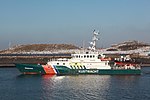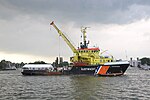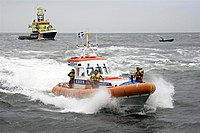Nederlandse Kustwacht
|
|||
|---|---|---|---|
| State level | Cooperation between 6 ministries in the Netherlands | ||
| position | Coast Guard monitoring / securing maritime traffic |
||
| Consist | since February 26, 1987 | ||
| Headquarters | Kustwachtcentrum Rijkszee- en Marinehaven 1 Den Helder Netherlands Province of Noordholland |
||
| Coordinates | 52 ° 57 '9.5 " N , 4 ° 47' 29.3" E | ||
| director | CDR Ronald J. Blok | ||
| Website | kustwacht.nl | ||
The Dutch Coast Guard ( Dutch Nederlandse Kustwacht ) is an independent civil organization with its own tasks, competencies and responsibilities. It is responsible for the safety and control of maritime traffic, including law enforcement, along the Dutch coastline and in the Dutch part of the North Sea .
aims
- a responsible use of the North Sea
- the guarantee of safety at sea
- compliance with national and international laws and obligations .
Responsibilities and cooperation
The Coast Guard is on behalf of the six ministries of the Netherlands operate:
- Ministry of Infrastructure and Water Management - responsible for road infrastructure and waterways, shipping (maritime affairs) and aviation.
- Ministry of Defense with the Dutch Armed Forces
- Ministry of Security and Justice - responsible for National Police Services , Prosecutor and National Crisis Center
- Ministry of Finance - responsible for taxes and customs
- Ministry of Economy and Climate Policy
- Ministry of Agriculture, Fisheries, Nature Conservation and Food Safety
The competent authorities of Rijkswaterstaat , the Maritime Police , the Royal Navy , the Royal Air Force , Customs , the Military Police , the Dutch Food and Consumer Protection Authority and the Inspection Agency for Environment and Transport provide the coast guard with staff. This ensures direct contact between the relevant authorities. The coast guard works very closely with the traffic control centers of the major ports ( Vlissingen , Rotterdam , Scheveningen , Amsterdam and Den Helder ) and the manned lighthouses of Schiermonnikoog , Terschelling and Ouddorp for the control of shipping .
tasks
The tasks of the Dutch coast guard are, on the one hand, official services:
- Monitoring, handling and coordinating emergency and urgency radio communications
- Maritime Aid, Search and Rescue (SAR)
- Limiting and managing the consequences of disasters (national and international)
- Ship traffic services on the open sea (traffic management and marking)
- Maritime research and surveys
- Disposal of explosives
and on the other hand, law enforcement tasks:
- General police duties to enforce and maintain law and order
- Customs supervision with supervision of the import, export and transit of goods
- Compliance with legislation related to the environment, sea fishing , nautical transport, marine equipment and offshore activities
- Border surveillance and control
Call Name : NETHERLANDS COASTGUARD
history
On the night of July 5th to 6th, 1882 the gunboat of the Dutch Navy 'Zr.Ms. Adder 'in a position less than 5 miles off the coast of Scheveningen . Of the 65 men of the crew, none survived the disaster. The tragedy did not become known until two days later when the first of 43 bodies washed up on the coast. The outrage in the Netherlands was great, because due to a communication error, the ship was not reported as missing. In response, a report was published in 1883 with the title “Het Houden van een uitkijk en het rapporteren van in nod verkerende schepen aan Hoofden Kustwacht” (keep an eye out and report ships in distress to the coast guard leaders). In the summer, the staffed lighthouses were instructed to report ships in distress off the coast of the Netherlands to the authorities.
With the advent of RADAR technology and improved means of communication, the area outside the coast could be better monitored after the Second World War . In addition, the government became more interested in the North Sea to protect its interests such as fishing, oil and gas exploration, sand and gravel extraction. This resulted in more than 20 government organizations with different responsibilities for the Dutch part of the North Sea and its coast. In order to end this fragmentation, the Ministry of Transport and Water Management ordered an investigation in 1984 with the aim of how the coast of the Netherlands could be guarded more efficiently and effectively. The results of this report were published in 1986 and led to the official establishment of the Dutch Coast Guard.
founding
The Nederlandse Kustwacht was founded on February 26, 1987. Initially, the headquarters of the coast guard was housed in a building belonging to the Scheveningen Radio coast station in IJmuiden . In 1995 the Coast Guard was assigned to the Ministry of Defense and therefore the headquarters moved to Den Helder on November 23, 2001 to the base of the Navy .
JRCC Den Helder
The Kustwachtcentrum ( English : Coast Guard Center ) in Den Helder is also known as the Joint Rescue Coordination Center (JRCC Den Helder), as it not only coordinates sea rescue ( MRCC ), but also air rescue ( ARCC ). A 24-hour watch with five people as the front office ensures that all emergency calls in the monitored area of the North Sea and the airspace of the Netherlands are recorded at all times . The paging name of the JRCC is DEN HELDER RESCUE . A back office serves to support the front office, to which the various databases of the authorities involved are available. In this way, all relevant information can be compiled in order to be able to cover all state issues or to find an integrated solution in the event of incidents or violations. The lifeboats of the Koninklijke Nederlandse Redding Maatschappij (KNRM) are alerted for the SAR services .
The director is CDR Ronald J. Blok.
Coast Guard fleet
The aircraft and ships of the various organizations, with the exception of the navy and police, appear in the same color to make all operational resources easier to recognize . The hulls of the ships are blue with a thin oblique blue stripe followed by a broad red / orange slash on a white background. The workboats have the same oblique stripes on a black hull with yellow superstructures. All ships are registered with the Dutch state shipping company (Rijsrederij) in Rijswijk . The three patrol boats were built at the Damen shipyard in Gorinchem . The emergency tug belongs to the towing and salvage company Multraship in Terneuzen and is rented from the Dutch Ministry of Infrastructure and Water Management under a charter contract .
| Surname | Type | berth | Construction year | length | Net tonnage | speed | photo |
|---|---|---|---|---|---|---|---|
| Barend Biesheuvel | Patrol boat | Scheveningen | 2001 | 61.43 m | 345 | 18 kn | |
| Visa end | Patrol boat | The hero | 2001 | 42.80 m | 245 | 22.5 kn |

|
| Zeearend | Patrol boat | Hook of Holland | 2002 | 42.80 m | 245 | 22.5 kn |

|
| Guardian | Emergency tug | The hero | 2013 | 65.72 m | 2637 | 20 kn | |
| Arca | Multifunction ship | Scheveningen | 1998 | 83.00 m | 2388 |

|
|
| Zirfaea | Research and measurement ship |
Scheveningen | 1993 | 63.00 m | 1261 |

|
|
| Frans Naerebout Terschelling Rotterdam |
Seaworthy buoy laying boat |
changing seaports |
1989 1988 1987 |
44.40 m | 514 | 12 kn |

|
| Nieuwe Diep Schuitengat Vliestroom Waddenzee. |
Buoy laying inland seas |
changing inland ports |
1999 1990 1988 1994 |
38.20 m | 288 | 12 kn |

|
Source: kustwacht.nl
The Royal Navy permanently provides the Coast Guard with an Alkmaar-class minesweeper , for B. carry out the fisheries control. If necessary, other naval units can also be used. If necessary, the police boats of the national police service can be used. Two patrol aircraft and several helicopters, including an offshore rescue helicopter, are available for missions from the air. The KNRM offers its 75 lifeboats for SAR services at 45 stations .
The former inlets in South Holland and Zeeland are also in the Coast Guard's area of responsibility. For this area, the coast guard has signed a contract with the private rescue and towing service Theunisse (BST-Dintelsas BV), which provides a fast lifeboat and a tug. This enables a SAR service around the clock in Haringvliet , Hollands Diep , Volkerrak and Krammer.
SAR Dornier Do 228
partner
In addition to the six ministries (see cooperation), the Coast Guard works closely with the following state and other partners:
- the Dutch rescue company KNRM;
- the rescue brigade Netherlands;
- the regional shipping centers along the Dutch coast;
- the Rijkswaterstaat North Sea Hydrometric Center;
- the maritime police team;
- of the SAR unit North Sea Helicopter Flanders (NHV)
- the satellite ground station in Burum;
- the cooperating operator of the Dutch oil and gas industry;
- the radio medical service of the KNRM;
- the rescue and towing company BST;
- the 16 security regions bordering the sea;
- the air traffic control centers Schiphol (civil aviation) and Nieuw-Milligen (military aviation);
- the rescue control centers (MRCC) in the surrounding North Sea countries, but also worldwide.
International cooperation
Traditionally and because of the shared use of the Scheldt estuary, there is close cooperation with the Belgian Coast Guard , which operates a coast guard center in Ostend . The Dutch Coast Guard is also a member of the international coastal protection forums:
- European Coast Guard Functions Forum (ECGFF)
- North Atlantic Coast Guard Forum (NACGF)
See also
- Kustwacht Caribisch Gebied (Coast Guard of the Kingdom of the Netherlands for the Dutch Caribbean)
Web links
- Official website (Dutch)
- SAR Services of the Netherlands (KNRM) (Dutch)
- International SAR agency website
- Rescue Brigade of the Netherlands
- North Sea Helicopter Flanders (NHV)
- Rijkswaterstaat hydrometric center (Dutch)
Individual evidence
- ↑ About us | Netherlands Coastguard In: kustwacht.nl , accessed on February 14, 2019.
- ↑ What we do | Netherlands Coastguard In: kustwacht.nl , accessed on February 14, 2019.
- ↑ History | Kustwacht Nederland In: kustwacht.nl , accessed on February 14, 2019.
- ↑ Contact | Kustwacht Nederland In: kustwacht.nl , accessed on February 14, 2019.
- ↑ CV Director Kustwacht | Kustwacht Nederland In: kustwacht.nl , accessed on February 14, 2019.
- ↑ Varende eenheden. Nederlandse Kustwacht, accessed December 12, 2018 (Dutch).







